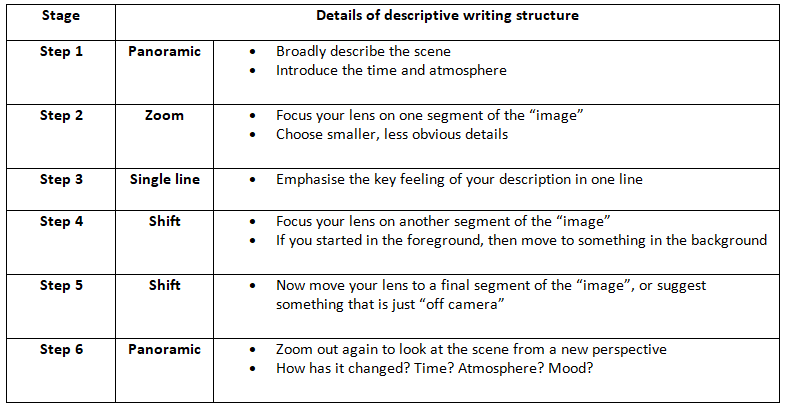Descriptive Writing: How to Score Full Marks | English Language for GCSE/IGCSE - Class 10 PDF Download
| Table of contents |

|
| Introduction |

|
| How to Structure Your Descriptive Writing |

|
| Descriptive writing techniques |

|
| Steps to Success |

|
Introduction
Section B necessitates writing with a defined purpose and in a specific format. Adhering to the conventions of this form is crucial, as the mark scheme emphasizes the importance of adjusting tone, style, and register for various forms, purposes, and audiences.
This means:
- The tone (the sound of the narrator’s “voice”) is appropriate and convincing
- The register (your vocabulary and phrasing) is suitable for the purpose
- The style of the writing (the sentence structure and the overall structure of your writing) is dynamic and engaging
- When strategizing your response, it's beneficial to consider the tone, style, and register, along with the conventions of the chosen form. Planning is crucial for any substantial writing task, so allocate 10 minutes to brainstorm your ideas before commencing writing. Here, we'll explore how to create a compelling piece of descriptive writing in the subsequent sections:
How to structure your descriptive writing - Descriptive writing techniques
- Steps to success
How to Structure Your Descriptive Writing
Descriptive writing entails observational writing, where the narrator doesn't engage with their surroundings or other characters. Characters aren't developed in this style of writing. Descriptive writing is akin to visualizing oneself behind a camera lens, capturing a moment in time. However, this doesn't imply that the scene described is stagnant; it's crucial to acknowledge the movements and actions observed.
Below is a suggested step-by-step structure for a piece of descriptive writing, including the techniques to use during each of the six steps:
While you can incorporate action or movement in your description, it shouldn't entail story advancement or interaction. Any action depicted should occur within a brief "real-time" span, like the wind toppling a basket. Introducing seemingly insignificant movements in the background, especially when contrasted with stationary elements, can be particularly effective.
Ensure your paragraphs are interconnected but diverse in size and structure. Diversity and precision are essential; you're vividly portraying a scene for your reader, enabling them to visualize it, hear it, perhaps even smell it!
Descriptive writing techniques
Tone
Descriptive writing should establish a tone that aligns with the scene's mood. This involves structuring sentences to mirror the atmosphere. For instance, in a mysterious and chilling setting, the sentences should evoke suspense.
To create an appropriate tone, consider varying sentence lengths and types:
- Short sentences convey tension and unease, like "No sound could be heard."
- Longer sentences and lists can evoke a feeling of being overwhelmed or abundant, for example, "The market was overflowing with apples, grapes, oranges, bread, cheese, and various vegetables."
Style and Register
- The style of descriptive writing is closely linked to the language employed. Effective descriptive writing showcases meticulous word selection and the purposeful application of linguistic techniques.
- Descriptive writing aims to help readers envision the person, location, or scenario under discussion. Through your choice of words and linguistic methods, you should evoke a vivid sensory experience in the reader's imagination.
The best way to do this is to:
- Employ vocabulary that enhances the reader's understanding:
- Avoid generic terms like "brilliant" or "amazing"; opt for precise and vivid adjectives.
- Utilize sensory language to immerse the reader in the scene:
- Describe not just visual elements but also auditory, olfactory, and tactile sensations.
- Highlight key ideas or impressions through language techniques and imagery:
- Employ similes to evoke associations regarding size or color.
- Personification can be effective, particularly when describing weather or inanimate objects.
- Ensure thorough description of significant details:
- Focus on important features rather than describing every aspect of a person or scene in exhaustive detail.
When considering the detail you should include in your description, it is useful to consider the types of things that bring a scene to life. These things are normally rooted in contrast. For example: Let’s consider the following example of an opening paragraph of a piece of descriptive writing:
Let’s consider the following example of an opening paragraph of a piece of descriptive writing:
Steps to Success
- Read the two task options carefully:
- Choose the one that you can visualize most effectively in your mind.
- Allocate 10 minutes for planning your writing:
- Utilize a mind-map or a table for structuring your thoughts. Consider using the "panoramic, zoom, single line, shift, shift, panoramic" six-step approach.
- Write down some reminders of figurative language or literary techniques to include, enhancing interest and detail:
- Jot down cues like "sound and silence," "movement and stillness," and "light and dark" to inspire your writing.
- Write your description, adhering to your initial plan:
- Compose your description while staying true to your planning.
- Try to reserve five minutes at the end to carefully review your writing, rectifying any evident errors:
- Allocate the last five minutes for a thorough proofreading, correcting any noticeable mistakes.
|
17 videos|45 docs
|
FAQs on Descriptive Writing: How to Score Full Marks - English Language for GCSE/IGCSE - Class 10
| 1. How can I structure my descriptive writing for the CIE IGCSE English Language exam? |  |
| 2. What are some key guidelines for creating vivid descriptions in descriptive writing? |  |
| 3. What is the importance of style and register in descriptive writing for scoring full marks in the CIE IGCSE English Language exam? |  |
| 4. What are some effective writing techniques that can help improve my descriptive writing for the CIE IGCSE English Language exam? |  |
| 5. How can I ensure success in scoring full marks for descriptive writing in the CIE IGCSE English Language exam? |  |














